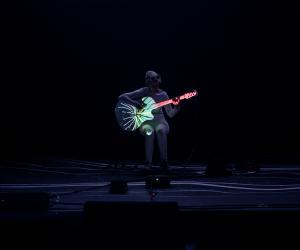Neri Oxman is at once an architect, an inventor, an engineer and a scientist. She is an American-Israeli designer and the founding director of The Mediated Matter Group at the MIT Media Lab. She and her team create unique designs that live somewhere in the crossing between environmental design and high-tech morphogenesis (the way organisms develop their shapes). She and members of her team will be joining the vanguard of international designers at this year’s Design Indaba Conference to present her team’s latest work.
Though rather hard to place in a single category, Oxman and her team’s work can be pared down to her passion for design in the bio-digital age. Her outlook as a designer and architect can perhaps be summarised by a phrase she coined herself – “material ecology”. Oxman and her team create structures and spaces across scales, from architectural pavilions to wearable garments, that question the conventions of the built world. Oxman received her PhD in Design Computation as a Presidential Fellow at MIT after attending Medical School at the Hebrew University in Jerusalem.
Along with her diverse team, this designer chips away at the fringes of synthetic biology. Their creations have led to over 100 scientific papers and engineering patents. They create novel design technologies, most of which are fabricated using 3D-printing, to test the bounds of the materials we know today. In this line of work, scale is no issue – Oxman has synthesised objects from micro to building-size, all of which derived from what she and her team see in nature.
For example, in 2015 Oxman and her team unveiled a “wearable skin” design called Mushtari. It allows living organisms to inhabit it and grow within a layer of synthetic skin. The 3D-printed design allows liquid, which houses light-generating photosynthetic organisms, to flow throughout the structure of the garment. Organisms can then grow within the skin and pass the energy from the sunlight to the wearer.
In 2016 Oxman and her team launched the second iteration of their optically transparent glass 3D printer, demonstrating its capabilities by designing, manufacturing and installing three 3-meter tall light fixtures at Milan Design Week.
Where designers of the previous Industrial Revolutions created new machines that propelled our societies forward with indifference to their environmental impact, Oxman makes ecology a central part of her approach. Most of her results are meant to be worn or touched, clearly inspired by the solutions already seized by evolution in nature.
Oxman sees the environments around us as organisms, changing constantly and responding to our interactions. Her creations reflect this. Her design pieces burst with colour and feature a range of surface textures – from fluidly smooth to harsh and scaly to the touch. Many of the Oxman Lab creations look like the vibrant inhabitants of deep-sea coral reefs, yet are entirely modern and made with cutting-edge design tools.
Since 2005, Oxman and her team have won numerous awards and has grown in international scope and acclaim at venues such as the World Economic Forum and the White House. Among Oxman’s awards are a Graham Foundation Carter Manny award (2008), the International Earth Awards for Future-Crucial Design (2008), the HOLCIM Next Generation award for Sustainable Construction (2008), a METROPOLIS Next Generation award (2009), a 40 Under 40 Building Design+Construction award (2012), the BSA Women in Design award (2014), the Vilcek Prize in Design (2014), an Emerging Voices award from the Architectural League of New York (2015), the Innovation by Design award from Fast Company (2015), and the San Jose Forum's Visionary Award (2017).
In 2008 Oxman was named "Revolutionary Mind" by SEED Magazine. In the following year, she was named to ICON’s “topmost influential designers and architects to shape our future” and to Esquire’s “Best and Brightest”. In the following year, Oxman was selected to FastCompany's “most creative people” and the “10 most creative women in business”. In 2014, Oxman was named to Carnegie’s Pride of America. In 2015, she was named to ROADS' 100 Global Minds: the Most Daring Cross-Disciplinary Thinkers in the World, and in 2016 she was named a Cultural Leader at the World Economic Forum.







